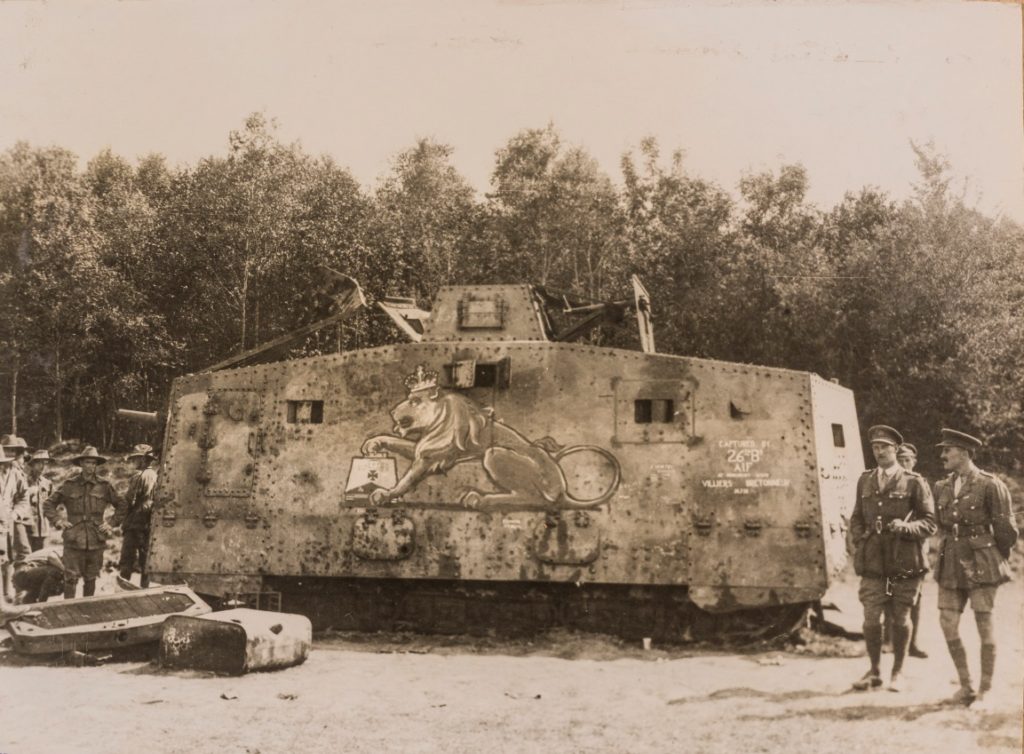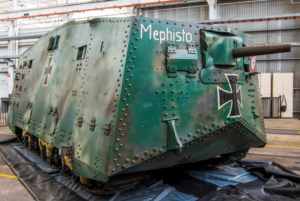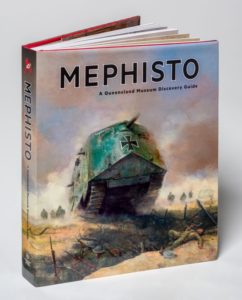Of the twenty German A7V Sturmpanzerwagen tanks built during the First World War, only one has survived intact. 506 Mephisto, recovered in the dead of night by Australian soldiers of the 26th Battalion from the Villers-Bretonneux battleground, survived thanks to its unlikely journey to Brisbane, Australia. 506 Mephisto is not only an incredibly rare tank, but a significant artefact of the First World War. The centenary of the capture and retrieval of Mephisto, and the tank’s connection to Queensland and Australia was marked in 2018.

Tanks, which began entering service from 1916, were a relative rarity on battlefields of the First World War. The first tanks were fielded by the British and French, so the German A7V was the product of the technological arms race that followed. A7Vs, which were essentially an armoured box mounted on a tracked chassis, weighed 30 tonnes and were capable of reaching speeds of up to 10kmh. Their armament consisted of eight MG08 machine guns (females) or a 57mm gun and six MG08 machine guns (males). The A7V was the creation of a team led by the automotive engineer Joseph Vollmer. The design of this the very first German tank began in 1916 but construction only commenced in late 1917. The first time the A7Vs were used in combat was at St Quentin in March 1918 during the opening day of the German Michael Offensive, and of the two vehicles which managed to take part in the action; one was 506 – later to be named Mephisto. In April 1918 the Germans came up against the Allied forces in the small, strategically placed town of Villers-Bretonneux, France. During the first day of the Second Battle of Villers-Bretonneux (24-27 April 1918), 506 Mephisto took part in the successful German attack but became stranded when the edge of a shell crater it was passing over collapsed under its weight.

The crew of Mephisto stripped the tank of much of its secondary weaponry and essential items before abandoning it. Mephisto lay in No Man’s Land for three months before its capture by the 26th Battalion AIF (commanded by Major, later Lieutenant-Colonel, James Robinson) on the night of 17/18 July 1918 and its subsequent recovery with the assistance of the British 1st Gun Carrier Company from under the noses of the German troops opposing them. The dangerous retrieval operation was undertaken on the night of 22-23 July 1918. Mephisto was still within sight of the German lines and retaliation was a real threat. Despite the danger, the soldiers carried out their plan. As it turned out, that very night the Germans unleashed a gas artillery barrage on the Villers-Bretonneux area. Many of the soldiers involved in the recovery operation were wounded as a result of the gas, but the operation was nonetheless successfully completed. The war prize Mephisto was now securely in Allied hands.
When it was made known that Mephisto would be sent to Australia, the Queensland Government began emphatically campaigning for the tank to be housed in Queensland. State Premier Thomas Joseph (J.T) Ryan, along with Governor Sir Hamilton John Goold-Adams and Lieutenant-Colonel Robinson, were instrumental in securing Mephisto for Queensland. Mephisto was sent to Brisbane on the SS Armagh, leaving England on 2 April, 1919. It arrived in Brisbane on the 2 June, and arguments very quickly began over where the tank should be displayed and housed. It was initially placed on display outside in the gardens of the Queensland Museum (then situated in Bowen Hills, Brisbane) where it remained as an iconic object greeting visitors for over sixty years. Since then the tank has had a number of new locations as part of the Queensland Museum collection, including a special loan to the Australian War Memorial in Canberra as part of the Centenary of the First World War. Mephisto’s long journey from the battlefields of Villers-Bretonneux began one hundred years ago and has finally comes to its conclusion. Mephisto has been relocated and now features as a major interpretative and commemorative display object in the Queensland Museum’s new Anzac Legacy Gallery that has been opened to mark the centenary of the Armistice for Remembrance Day 2018.

To commemorate the centenary anniversary of A7V Mephisto’s capture and recovery, Queensland Museum has released a fully illustrated reference guide to the tank’s history and its journey to Australia. The story of Mephisto is interwoven with the events of the First World War, the dramatic evolution of the science, technology and tactics of war, and especially the Western Front experience. Australia’s greatest and most costly contributions to the allied war effort were made during the bloody years of 1916-18 on the Western Front. Mephisto: Technology, War, and Remembrance by Jeff Hopkins-Weise and Gregory Czechura includes personal accounts, technical schematics, photographs and newly-discovered details about this incredible First World War artefact. Find out more about the men who risked life and limb to retrieve Mephisto under a hail of gas shells, and how this tank came to be the sole surviving example of a German A7V. Mephisto comprehensively details the history of this primitive armoured vehicle against the backdrop of the industrial innovations and societal changes of the First World War.
Mephisto: Technology, War and Remembrance is available now through the Queensland Museum Shop website
To see the rarest tank in the world in person, visit the Anzac Legacy Gallery at:
Queensland Museum
Grey St & Melbourne St
South Brisbane
QLD, Australia
Contact Military History and Heritage Victoria about this article.






